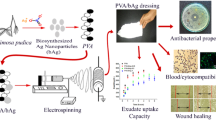Abstract
Fungating wounds usually develop in patients with advanced cancer, which responds poorly to treatments. Such wounds can be treated using suitable dressings. For this purpose, a recent research produced a new type of wound dressing with antibacterial and anticancer properties. The culture supernatant of Fusarium oxysporum was challenged with silver nitrate and heated for 5 min. Production of silver nanoparticles (SNPs) was confirmed using spectrophotometer, transmission electron microscopy (TEM), and X-ray diffraction (XRD) analysis. A solution of 10% (w/w) poly vinyl alcohol (PVA) and different volumes of SNP solutions were provided, where each solution was separately used for electrospinning. The obtained PVA/SNPs film evaluated under morphological characterization using field emission scanning electron microscope (FE-SEM) and its antibacterial and anticancer activities were measured. Results confirmed the presence of SNPs in the reaction mixture with sizes less than 50 nm, spherical and oval in shapes. FE-SEM results confirmed that SNPs were seen inside and entrapped between PVA in the PVA/SNPs membrane, composed of 50% of each material. This film had acceptable antibacterial properties against four different bacterial strains and a good anticancer activity against the human melanoma cell line (COLO 792) in contrast to the control one. A recent research introduced a new and fast biological method for the synthesis of SNPs, having acceptable antibacterial and anticancer activities. Further studies are needed to support the obtained results.








Similar content being viewed by others
References
Adderley UJ, Holt IGS (2014) Topical agents and dressings for fungating wounds. The Cochrane Library, London
Aruan NM, Sriyanti I, Edikresnha D, Suciati T, Munir MM (2017) Polyvinyl alcohol/soursop leaves extract composite nanofibers synthesized using electrospinning technique and their potential as antibacterial wound dressing. Procedia Eng 170:31–35
Augustine R, Kalarikkal N, Thomas S (2016) Electrospun PCL membranes incorporated with biosynthesized silver nanoparticles as antibacterial wound dressings. App Nanosci 6(3):337–344
da Silva LCA, Honorato TL, Cavalcante RS, Franco TT, Rodrigues S (2012) Effect of pH and temperature on enzyme activity of chitosanase produced under solid stated fermentation by Trichoderma spp. Indian J Microbiol 52(1):60–65
He Y, Du Z, Ma S, Liu Y, Li D, Huang H, Zhang K (2016) Effects of green-synthesized silver nanoparticles on lung cancer cells in vitro and grown as xenograft tumors in vivo. Int J Nanomed 11:1879
Hong KH (2007) Preparation and properties of electrospun poly (vinyl alcohol)/silver fiber web as wound dressings. Polym Eng Sci 47(1):43–49
Jang SJ, Yang IJ, Tettey CO, Kim KM, Shin HM (2016) In-vitro anticancer activity of green synthesized silver nanoparticles on MCF-7 human breast cancer cells. Mater Sci Eng C 68:430–435
Kamarul T, Krishnamurithy G, Salih ND, Ibrahim NS, Raghavendran HRB, Suhaeb AR, Choon DSK (2014) Biocompatibility and toxicity of poly (vinyl alcohol)/N,O-carboxymethyl chitosan scaffold. Sci World J 2014. https://doi.org/10.1155/2014/905103
Lee S-Y, Pereira BP, Yusof N, Selvaratnam L, Yu Z, Abbas AA, Kamarul T (2009) Unconfined compression properties of a porous poly (vinyl alcohol)–chitosan-based hydrogel after hydration. Acta Biomater 5(6):1919–1925
Merz T, Klein C, Uebach B, Kern M, Ostgathe C, Bükki J (2011) Fungating wounds–multidimensional challenge in palliative care. Breast care 6(1):21–24
Mortimer P (1998) Management of skin problems: medical aspect. Oxford University Press, Oxford, pp 617–627
Paper JM (2011) Secreted proteins from the plant pathogenic fungus Fusarium graminearum: identification, role in disease, and biotechnological applications: plant biology. Michigan State University, East Lansing
Pourali P, Yahyaei B (2016) Biological production of silver nanoparticles by soil isolated bacteria and preliminary study of their cytotoxicity and cutaneous wound healing efficiency in rat. J Trace Elem Med Biol 34:22–31
Pourali P, Baserisalehi M, Afsharnezhad S, Behravan J, Alavi H, Hosseini A (2012) Biological synthesis of silver and gold nanoparticles by bacteria in different temperatures (37 and 50 °C). JPAM 6:757–763
Pourali P, Baserisalehi M, Afsharnezhad S, Behravan J, Ganjali R, Bahador N, Arabzadeh S (2013) The effect of temperature on antibacterial activity of biosynthesized silver nanoparticles. Biometals 26(1):189–196
Pourali P, Yahyaei B, Ajoudanifar H, Taheri R, Alavi H, Hoseini A (2014) Impregnation of the bacterial cellulose membrane with biologically produced silver nanoparticles. Curr Microbiol 69(6):785–793
Pourali P, Razavian NZ, Yahyaei B (2016) Silver nanoparticles production by two soil isolated bacteria, Bacillus thuringiensis and Enterobacter cloacae, and assessment of their cytotoxicity and wound healing effect in rats. Wound Repair Regen 24(5):860–869
Pourali P, Badiee SH, Manafi S, Noorani T, Rezaei A, Yahyaei B (2017) Bio-synthesis of gold nanoparticles by two bacterial and fungal strains, Bacillus cereus and Fusarium oxysporum, assessment and comparison of their nanotoxicity in vitro by direct and indirect assays. Electron J Biotechnol 29:86–93
Queen D, Orsted H, Sanada H, Sussman G (2004) A dressing history. Int Wound J 1(1):59–77
Samarel N, Leddy SK, Greco K, Cooley ME, Torres SC, Tulman L, Fawcett J (1996) Development and testing of the symptom experience scale. J Pain Symp Manag 12(4):221–228
Seaman S (2006) Management of malignant fungating wounds in advanced cancer. Semin Oncol Nurs 22(3):185–193
Yahyaei B, Arabzadeh S, Pourali P (2014) An alternative method for biological production of silver and gold nanoparticles. JPAM 8:4495–4501
Yahyaei B, Peyvandi N, Akbari H, Arabzadeh S, Afsharnezhad S, Ajoudanifar H, Pourali P (2016) Production, assessment, and impregnation of hyaluronic acid with silver nanoparticles that were produced by Streptococcus pyogenes for tissue engineering applications. Appl Biol Chem 59(2):227–237
Funding
This study was not any fund.
Author information
Authors and Affiliations
Corresponding author
Ethics declarations
Ethical approval
No ethical problem in this study.
Conflict of interest
All authors declare that they have no conflict of interest.
Additional information
Publisher’s note
Springer Nature remains neutral with regard to jurisdictional claims in published maps and institutional affiliations.
Rights and permissions
About this article
Cite this article
Yahyaei, B., Manafi, S., Fahimi, B. et al. Production of electrospun polyvinyl alcohol/microbial synthesized silver nanoparticles scaffold for the treatment of fungating wounds. Appl Nanosci 8, 417–426 (2018). https://doi.org/10.1007/s13204-018-0711-2
Received:
Accepted:
Published:
Issue Date:
DOI: https://doi.org/10.1007/s13204-018-0711-2




